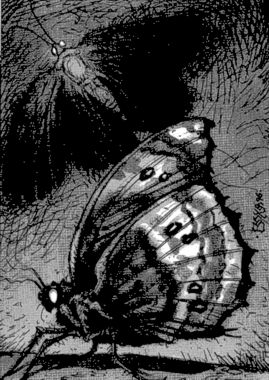Rumor speaks of a wizard’s guild, secretive and nameless, that manipulated peasant, merchant, and king alike from its underground school
deep beneath the city. Entering and leaving through the sewer pipes, the wizards remained cloaked in mystery for years. One day, a civil war broke
out among their ranks. An evil necromancer, cruel and hungry for power, attempted to take over the school. By the end of that day, every other
member of the guild died rather than submit to his rule.
In time, the necromancer met his own special doom. Old age overtook him, and he wasted away in the solitude of his underground kingdom. As the end
approached, the necromancer began working frantically, trying to discover the secret of lichdom before death took him. He conducted experiment
after foul experiment, and the waste from these projects was casually dumped into the sewer or thrown into a shadowy corner. With the last of his
strength, the necromancer stirred his iron cauldron, staring hopefully at the crimson goop bubbling within. Without warning, the goop slithered
out of the pot and rushed up the old wizard’s arm, enveloping him, plugging his nose, and surging into his mouth. It clung to his skin like a coat
of blood. In seconds, the necromancers wicked spirit flew howling into Acheron.
Most people in the city above were cozily ignorant of these events. Indeed, no one would have learned of the necromancer’s experiments had he
been more tidy. As it was, decades of alchemic pollution had permanently altered the denizens of the sewers. They had become tougher, smarter,
and almost immune to magic. The first sign of trouble was when the rats fled to the surface…
by John Baichtal
These peculiar creatures were created by the wizard in an attempt to manufacture potions “naturally”. The moths turned out less than perfect, with a tendency to produce bad potions and an intense craving for blood. They are huge gray moths with luminescent green eyes. They feast on blood much as do stirges, but their magical venom slays more often - and more spectacularly - than does their physical attack.
Combat: Plague moths typically attack in large swarms, but no more than three moths assault the same target - the others seek out other victims rather than fight over the same prey. While plague moths are agile and nearly immune to magic, their greatest asset is a magically venomous bite. Each moth has its own venom, equivalent to a randomly-determined potion from Table 89 in the DMG. Treat any result of potion of healing, any oil, or any potion with an XP value of 300 or higher as a potion of delusion (of extra healing, giant strength, or some other beneficial effect). The most dangerous result of a plague moth attack comes when a victim is bitten by more than one moth; then the victim must roll on Table 111: Potion Compatibility, ignoring the rule that makes a potion of delusion compatible with all other potions. Plague moths are immune to the venom of all of their kind. Note that unlike stirges, plague moths typically wait until their prey is dead before feeding.
Habitat/Society: Plague moths live in swarms that are dormant half the time, hunting the other half. As they live in the sewers, day and night have no meaning to them. On the very rare instances in which plague moths have emerged from the sewers, they have been active only at night.
Ecology: As a blood-drinking predator, the plague moth tends to attack all living things and therefore has a huge impact on the food chain. However, being fairly weak, they are easily killed by other monsters and have so far failed to overrun the sewers. The more intelligent sewer creatures have learned not to eat the plague moths after witnessing or experiencing firsthand the dangerous and unpredictable effects of their venom. Attempts to harness their potion-generation ability have thus far failed by those few who have managed to capture one alive, as the moths soon wither and die in captivity.


